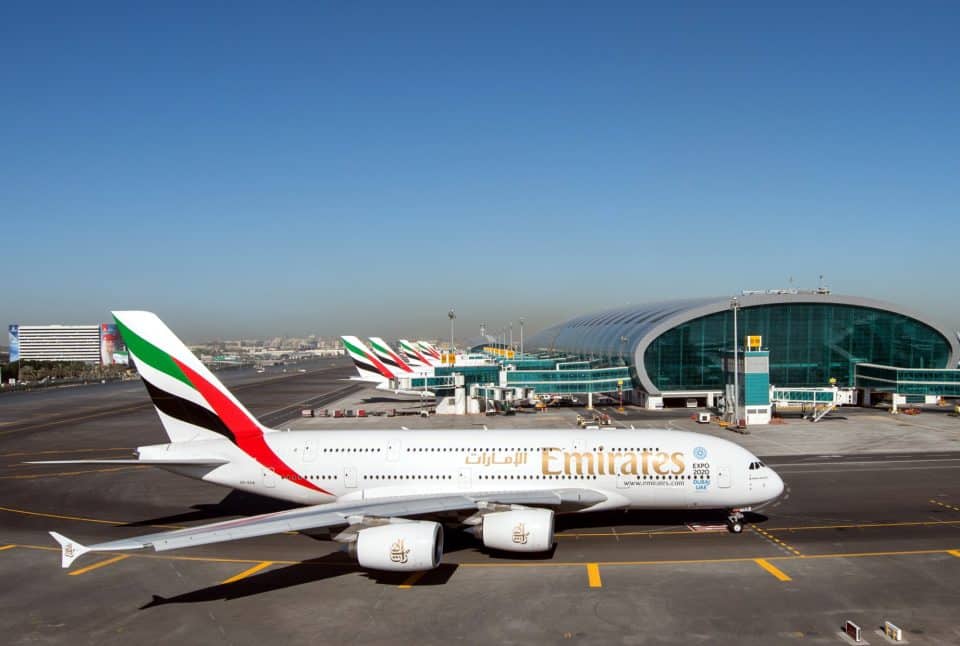Airlines
Emirates ramps up operations across continents

Emirates has boosted operations by 31% (total ASKMs) since the start of its financial year and has further plans to ramp up seat capacity in its latest published northern summer schedule starting 26 March 2023.
In the past months, the airline has planned and executed the rapid growth of its network operations – reintroducing services to 5 cities; launching flights to 1 new destination (Tel Aviv), adding 251 weekly flights onto existing routes; and continuing the roll-out of service enhancements in the air and on the ground.
Qantas Takes off again between Brisbane and Tokyo(Opens in a new browser tab)
In the coming months, established routes to Europe, Australia and Africa will be served with more Emirates flights, while in East Asia, more cities are seeing route restarts.
Upcoming A380 deployments in Northern Summer 2023 season:
Emirates continues to scale up its A380 operations with the reintroduction of the iconic double-decker across its network: Glasgow (from 26 March), Casablanca from (15 April), Beijing (from 01 May), Shanghai (from 04 June), Nice (from 1 June), Birmingham (from 1 July), Kuala Lumpur (from 01 August), and Taipei (from 01 August).
Upcoming route enhancements by region:
Europe
- Amsterdam: from 14 to 19 weekly flights starting 02 April.
- Athens: Addition of a daily seasonal service to serve summer demand between 01 June to 30 September.
- Bologna: from 5 flights a week to a daily service starting 01 May.
- Budapest: from 5 flights a week to a daily service by 01 June.
- London: start of 2nd daily service to London Stansted on 01 May. This will take Emirates’ London operations to 11 daily flights – including 6 times daily to London Heathrow and 3 times daily to Gatwick.
- Venice: from 5 to 6 flights a week from 26 March, increasing to a daily service from 01 June.
Africa
- Cairo: from 25 to 28 weekly flights by 29 October.
- Dar es Salaam: from 5 flights a week to daily flights starting 01 May.
- Entebbe: from 6 flights a week to daily flights starting 01 July.
Australia and New Zealand
Emirates’ non-stop Australia flights will return to pre-pandemic levels to Sydney from 01 May, Melbourne from 26 March, and Brisbane on 01 June.
- Brisbane: An additional daily service starting 01 June will take Emirates to 14 flights per week to Brisbane.
- Christchurch: restart of daily service from Dubai via Sydney from 26 March.
- Melbourne: addition of 3rd daily service to Melbourne from 26 March via Singapore. This adds capacity to Melbourne and re-establishes connectivity between Singapore and Melbourne. The other 2 daily flights from Melbourne fly non-stop to Dubai.
- Sydney: addition of 3rd daily non-stop service from 01 May.
East Asia
- Bangkok: Addition of 5th daily service from 01 August.
- Beijing: To commence daily non-stop Boeing 777-300ER service from 15 March, upgrading to an A380 effective 01 May. A second daily service will commence effective 01 September with an A380.
- Hong Kong: Addition of a daily non-stop flight from 29 March. This increases Emirates’ operations to 14 weekly flights including its existing daily Dubai-Bangkok-Hong Kong service.
- Kuala Lumpur: Addition of a third daily service from 01 June.
- Tokyo: Resumption of services to Tokyo Haneda with daily flights on 02 April. This takes Emirates’ Japan operations to 21 weekly flights including a daily A380 service to Tokyo-Narita and a daily Boeing 777 service to Osaka.

Airlines
Air India’s last VVIP Boeing 747 now found a new home in USA

In a symbolic transition marking the end of a storied chapter in aviation history, Air India bid farewell to its last remaining Boeing 747-400 jumbo jetliners, once revered for ferrying dignitaries including prime ministers, presidents, and vice presidents.
The sale of these iconic aircraft to AerSale, a company based in the United States, signals the closure of a remarkable era for the airline.
The decision to part ways with the Boeing 747s was driven by practical considerations. Tata Group, the new custodian of airindia flights, deemed these majestic planes uneconomical to operate in today’s aviation landscape. As such, out of the four sold, two will be repurposed into freighters, while the remaining pair will be meticulously disassembled to harness their valuable parts.
The transaction, orchestrated by Mumbai-based Vman Aviation Services, underscores the strategic shift in Air India’s fleet management strategy under its new ownership. Tata Group’s decision to divest from the 747s reflects a commitment to optimizing operational efficiency and aligning with contemporary industry standards.
Skytech-AIC, a UK-based remarketing firm engaged by Tata Group, facilitated the sale of these iconic aircraft, marking the conclusion of their illustrious service with Air India. The airline’s last flight featuring the Boeing 747 took to the skies between Delhi and Mumbai in March 2021, encapsulating decades of distinguished service and indelible memories.
The allure of used aircraft parts continues to resonate across the aviation sector, offering operators a cost-effective alternative without compromising on quality or performance. The transfer of these aircraft to AerSale not only ensures their continued utility but also underscores the enduring legacy of Air India’s fleet.
Airlines
A software error caused grounding the entire airline fleet

On Wednesday, the U.S. Federal Aviation Administration (FAA) issued a ground stop advisory for all Alaska Airlines and subcarrier flights due to a software issue, disrupting travel plans for passengers.
The FAA directive, which prohibited the departure of Alaska Airlines mainline and subcarrier flights, was implemented as a precautionary measure following the detection of the software problem. The ground stop was initiated after Alaska Airlines encountered difficulties during a system upgrade related to the calculation of weight and balance for their flights.
As a result, the airline opted for a temporary suspension of all its operations to address the issue and ensure passenger safety. Alaska Airlines promptly issued a statement acknowledging the incident and expressing their commitment to resolving the matter swiftly. “This morning we experienced an issue while performing an upgrade to the system that calculates our weight and balance.
Out of an abundance of caution, we requested a ground stop for all Alaska and Horizon flights, which was instituted at approximately 7:30 a.m. PT,” the statement read. Passengers affected by the disruption voiced their concerns on social media platforms, prompting Alaska Airlines to reassure them of their efforts to minimize the inconvenience and expedite the resumption of flights.
Following approximately an hour-long interruption, the FAA lifted the ground stop order, allowing Alaska Airlines and its subcarriers to resume normal operations. However, it was clarified that SkyWest, which provides regional service for Alaska Airlines and other carriers, was exempt from the ground stop and continued its flights unaffected.
Aerospace
Which is bigger 777x or 787 aircraft ?

The 777X is a new series of the Boeing 777 family and is designed to be larger and more efficient than its predecessor. It features two variants: the 777-8 and the 777-9, being the larger of the two.
The Boeing 777X emerges as the larger sibling within the Boeing family, representing a significant leap forward in both size and efficiency. Comprising two variants, the 777-8 and the 777-9, the latter takes the crown as the larger of the two. With its expansive fuselage and impressive wingspan, the 777X is tailored for long-range journeys and boasts a substantial passenger capacity.
On the other hand, the Boeing 787, affectionately known as the Dreamliner, occupies a niche in the market as a smaller yet formidable aircraft designed for medium to long-range flights. Its distinguishing feature lies in its composite fuselage, a technological marvel that renders it lighter and more fuel-efficient compared to conventional aluminum counterparts. The Boeing 777X is larger than the Boeing 787 aircraft.
When it comes to passenger capacity, the 777-9 reigns supreme, typically accommodating a sizeable contingent of 400-425 passengers in its standard configuration. In contrast, the 787, with its more modest dimensions, typically carries between 240-290 passengers, depending on the variant and layout.
One of the remarkable innovations introduced with the 777X is its folding wingtips, a feature designed to address the logistical challenges of accommodating such a large aircraft in conventional airport gates. These folding wingtips enable the 777X to retract its wings, allowing it to fit into gates designed for smaller aircraft while still reaping the benefits of an extended wingspan during flight, thereby enhancing fuel efficiency and operational flexibility



























